The Adverse Effects of Cellulosic Material in Isolator Barrier Technology
The authors focus on the effects of cellulosic materials during the performance qualification validation of a transfer barrier isolator used for the purpose of sterility testing.
Barrier isolation technology has advanced in pharmaceutical production and processing. Two categories of barrier isolation systems are used in pharmaceutical development: containment isolation systems, which operate under negative pressure to protect the operator from exposure to the contents of the isolator interior such as toxic substances, and aseptic isolator systems, which protect the isolator contents from contamination by the operator and the surrounding environment.
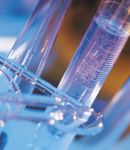
Aseptic isolators protect the contents of an isolator by generating positive pressure to restrict contaminants from entering the isolator. Generally, HEPA-filtered air is introduced into the isolator by programmable logic control (PLC) blowers that maintain the isolator interior pressure at a level slightly higher than the surrounding room pressure.
Aseptic isolators can be further categorized into two types: processing and testing. Processing isolators are used in typical production applications. Examples of processing isolators include filling-line isolators, formulation isolators, and packaging isolators. Processing isolators replace traditional aseptic processes in pharmaceutical production facilities to reduce the risk of introducing contaminants into the product.
Testing isolators or sterility-testing isolators are used to perform trials on both in-process and finished products. Sterility test isolators are intended to replace traditional sterility-testing practices and to reduce false positives and subsequent wasted product as a result of flawed sterility testing (1, 2).
This article focuses on tests conducted on an aseptic sterility-testing isolator. The analysis and conclusion, however, may be applicable to any isolator system.
Reducing the number of false-positive results in a sterility-testing isolator depends on the efficacy of the isolator bio-decontamination. Bio-decontamination of an isolator and its contents eliminates or reduces the number of biological contaminants in the isolator, reducing the risk of sample contamination and a false-positive result.
A chemical sterilant, typically vapor hydrogen peroxide (VHP), can be used in the bio-decontamination process (3, 4). VHP bio-decontamination is accomplished by connecting the isolator to a commercially available VHP generator, which pretreats the interior of the isolator and then introduces VHP into the isolator's interior. After sufficient VHP dwell time (validated duration), the residual VHP is removed from the isolator interior during an aeration stage.
Validation requirements
For any biological decontamination or sterilization procedure, validation studies must be conducted to prove robustness. A bio-decontamination cycle must inactivate an appropriate biological challenge. Numerous publications indicate that Geobacillus stearothermophilus is an appropriate biological challenge to a VHP decontamination process (3, 4). The US Food and Drug Administration also has guidelines about the initial population of an appropriate biological challenge for isolator systems. FDA's aseptic processing guidance indicate that a four to six log reduction can be justified depending on the application (5).
Chemical indicators (CI) and thermocouples (TC) are distributed throughout the interior of the isolator during the validation studies. The CIs take a gross measure of VHP distribution to ensure that the VHP has reached all locations within the isolator. Thermal mapping of the isolator is performed to determine the thermal characteristics of the VHP decontamination cycle for comparison with the saturation point.
In addition to thermal, chemical, and biological mapping of the isolator, measurement of VHP concentration during the validation runs is suggested per the aseptic guidance. Finally, all testing must be conducted for minimum and maximum load configurations to represent worst-case conditions.
Design requirements
Several minimum requirements must be met in the design of isolators, as stated by FDA. An isolator must provide sufficient flow to cover all isolator surfaces. In addition, the flow must remain dynamic throughout operation (i.e., no stagnant areas should be present) and pass through a series of HEPA filters. The inlet airflow must be regulated so that the isolator maintains a pressure differential during operation.
Depending on the application of the isolator, the air quality standards of the interior of the isolator should meet Class 100 standards. The surrounding environment should generally meet Class 10,000 or Class 100,000 requirements (5).
The isolator must be constructed of durable materials that can be cleaned and sterilized easily. Title 21 of the Code of Federal Regulations Part 211.65a states that all equipment materials must not cause an interaction such that the drug product is altered in any way (6). Some materials used in isolator construction that are appropriate for use with VHP are made from various grades of stainless steels, glass, polyvinyl chloride (PVC), Hypalon, and Neoprene.
According to Rickloff, VHP generator use began in the early 1990s. The generators flash-vaporize aqueous solutions of hydrogen peroxide and safely and effectively deliver the gaseous mixture to an isolator (7).
For this validation, an Amsco VHP generator series 1000 (STERIS Corporation, Mentor, OH) was used. The generator goes through four phases to decontaminate an isolator at near atmospheric pressure:
- Phase 1, Dehumidification: The humidity within the isolator is reduced to an established set point.
- Phase 2, Ramping: The hydrogen peroxide injection rate is quickly increased to reach the desired enclosure VHP concentration.
- Phase 3, Bio-decontamination: A continuous flow of VHP is delivered to the isolator enclosure for a predetermined length of time.
- Phase 4, Aeration: The delivery of VHP is stopped; and the residual VHP in the isolator enclosure is reduced to a desired part per million count.
Restrictions
Despite the proven track record of VHP bio-decontamination, there are restrictions to the process that can influence efficacy. One such restriction is the control of temperature and water vapor content within the enclosure. In the Amsco series 1000 generator, temperature and water content must be regulated to prevent condensation. Furthermore, materials introduced into the isolator system must be chosen carefully to prevent an adverse interaction with the VHP.
Methods and materials
This case study was conducted through a La Calhène two-glove transfer isolator with an approximate working volume of 21 ft3 , similar to the isolator shown in Figure 1. All materials to be used for sterility testing in an adjacent workstation isolator were first decontaminated in the transfer isolator and then aseptically transferred to the sterility test isolator. The transfer isolator was equipped with two internal recirculation fans to facilitate air circulation and two HEPA filters—one each at the inlet and outlet—to remove particles from the airflow. The internal pressure was monitored with a liquid manometer.
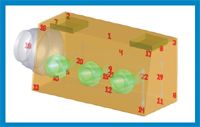
Figure 1: An isolator showing the distribution of 27 biological indicators, chemical indicators, and thermocouples in a two-glove transfer isolator. Five locations are not visible from this angle.
An Amsco VHP generator series 1000 delivered decontaminant to the isolator. The isolator decontamination process continued to a manual aeration phase to further reduce postprocess residual VHP. For the manual aeration stage, the exhaust of the isolator was connected to an internal laboratory exhaust system.
VHP and water concentrations were monitored during the bio-decontamination cycle by near-infrared spectrophotometry measurements using a guided wave (8). A measurement probe was placed inside the isolator, and the concentrations were measured during the conditioning and exposure phases of the decontamination cycle.
The load consisted of eight test tube racks each carrying 24 100-mL test tubes filled with soybean casein digest broth (TSB) or fluid thioglycollate media (FTM), which will be referred to as the load.
Before entering the transfer isolator for routine processing, the load materials were steam sterilized by a validated cycle. After the autoclave cycle, the load items were transported to the isolator. For postprocess protection, the load was wrapped before autoclave sterilization with a steam-sterilization wrap.
Commercially available G. stearothermophilus BIs were used with a nominal initial population to demonstrate six-log reduction. The organisms were inoculated onto stainless steel carriers and packaged into double-sided Tyvek (DuPont, Willmington, DE) pouches. The manufacturer label claim indicated a 1.2-min D-value evaluated at an exposure of 2-mg/L VHP concentration. The heat shock population count yielded 1.7 × 106 cfu/carrier. The resistance of the biological indicators was confirmed through a VHP biological indicator evaluator resistometer (BIER) (9) (VHyPer, PSI, Mundelein, IL). The biological indicator also was ribotyped through a Qualicon RiboPrinter (Dupont) to confirm the ATCC genus and species (10).
A total of 27 BIs, CIs, and thermocouples were placed throughout the isolator (see Figure 1). Twenty-three of the locations were predetermined before execution on the basis of geometric mapping. An additional four locations were challenged as a result of potentially poor gas flow as identified in airflow (smoke test) pattern tests.
To ensure an acceptable spore log reduction and an additional level of safety, the BIs were exposed at a three-quarter decontamination cycle time, as compared with the normal cycle duration used for routine decontamination.
Results and discussion
Three consecutive runs were performed with the load wrapped with outer wrap. These three runs resulted in 17 out of the total 81 BIs exhibiting growth after incubation at 55–60 °C. An out-of-specification (OOS) investigation into the cause of the positive BIs was initiated. Upon investigation, the probable cause was hypothesized to be the outer wrap material of the load. Investigation of the material properties of the wrap concluded that the wrap was made of cellulosic material, which is a known absorber of VHP.
Upon establishment of the probable root cause, three additional runs were conducted with the cellulosic material removed. All other exposure parameters and conditions were held constant. These additional runs were repeated to test the hypothesis that the cellulosic material was absorbing a significant amount of VHP and therefore reducing the effectiveness of the decontamination cycle.
A comparison of the VHP concentration between the first three and the second three runs demonstrates the dramatic effect of the cellulosic material on the concentration of VHP in the isolator. The data shown in Figure 2 indicates that the cellulosic material absorbed a significant amount of VHP.
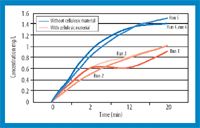
Figure 2: : Concentration versus time plots for load bio-decontamination from the beginning of the conditioning phase through the bio-decontamination phase. Note the difference in concentration profile exhibited by the loads with cellulosic material included.
The accumulated VHP concentration (∫VHPdt) is introduced as a means to quantify and compare the accumulated VHP concentration between runs. The accumulated VHP concentration is calculated by integrating the VHP concentration over time during the decontamination cycle and provided in units of mg/L-min.
The accumulated VHP concentration is useful for quantifying the amount of delivered sterilant in an isolator. VHP concentration and time are two variables that can affect the accumulated VHP concentration.
The ∫VHPdt values for the six runs are presented in Table I. Runs executed with the cellulosic material present, on average, produced an accumulated VHP concentration (VHPdt) of 14.86 mg/L-min, as compared with 24.58 mg/L-min without the cellulosic material. Removal of the cellulosic materials amounted to a 65% increase in accumulated VHP concentration.

Table I: The numerical integration data for load bio-decontamination.
It is important to note the location of positive BIs, as shown in Table II. Of the 17 positive BIs, only one location (number 27) was repeated (Runs 1 and 2). The random dispersion of the positive BIs from run to run indicates that the reduction in VHP concentration created a marginal non-uniform cycle.
The observed decrease of VHP concentration in the presence of cellulosic material can be attributed to several phenomena, including both absorption and catalytic breakdown. Average VHP concentration in the transfer isolator containing cellulose wrap was 0.97 mg/L. In contrast, the same isolator (decontaminated with the same cycle parameters, and load without cellulosic material) had an average VHP concentration of 1.43 mg/L—a 47% increase on average.
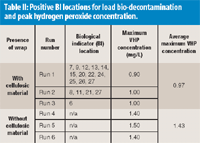
Table II: Positive BI locations for load bio-decontamination and peak hydrogen peroxide concentration.
Absorption can occur such that hydrogen peroxide molecules are held to the hydroxyl groups of cellulose by fundamental hydrogen bonding. An interaction with the cellulosic material may trigger a various rate of hydrogen peroxide degradation to water and oxygen (11). Some scientists support the catalytic theory, stating that there exists an occurrence of catalytic decomposition of hydrogen peroxide when in contact with both heavy and transition metals (12).
The quantification of the effects of each of these phenomena requires further research under tightly controlled conditions.
Conclusion
Packaging material will retard the rate of penetration of vaporized hydrogen peroxide to the biological indicators even if it is gas permeable. In some cases this situation could lead to biological indicator positives. For example, Tyvek is a gas-penetrable wrapping material that has a minimal affect on biological indicator performance because it is neither reactive nor significantly absorbent and can be used successfully.
Cellulosic material is disadvantageous for use as a wrapping material during decontamination by VHP in isolator barrier systems. Its chemical structure contributes to the absorption of VHP, and can catalyze the breakdown of H2 O2 . Cellulosic material must be limited in VHP decontamination cycles. If a sterilization wrap is required in a VHP bio-decontamination process, it should be non-cellulosic.
The deleterious effect of cellulosic materials to the efficacy of VHP decontamination cycles has been demonstrated to cause validation failures. Therefore, a validation scientist must continue to be diligent all load contents before either developing or qualifying a barrier isolation system.
Robert Reich is the chief science officer and Ross A. Caputo, PhD,* is the chief executive officer both at PSI, 909 Orchard St., Mundelein, IL 60060, tel. 847.566.9229, fax 847.566.4960, rcaputo@pharmsystems.com
References
1. C.M. Wagner and J. Raynor, "Industry Survey on Sterility Testing Isolators: Current Status and Trends," Pharm. Eng. 21 (2), 124–140 (2001).
2. J.C. Lyda, "Regulatory Aspects of Isolator/Barrier Technology," PDA Pharm. Sci. Tech. 49 (6), 200–304 (1995).
3. Amsco VHP 1000 Biodecontamination System Cycle Development Guide (STERIS Corporation, Mentor, Ohio, 1998).
4. M. Kokubo, T. Inoue, and J. Akers, "Resistance of Common Environmental Spore of the Genus Bacillus to Vapor Hydrogen Peroxide," PDA Pharm. Sci. Techol. 52, 228–231, (1998).
5. FDA, Guidance for Industry:Sterile Drug Products Produced by Aseptic Processing—Current Good Manufacturing Practice (FDA, Rockville, MD, 2004).
6. Code of Federal Regulations, Title 21, Food and Drugs (General Services Administration, Washington, DC, Apr. 1, 1973), Part 211.65.
7. J.R. Rickloff, "Key Aspects of Validating Hydrogen Peroxide Gas Cycles in Isolator Systems," J. Val. Technol.5 (1), 61–71 (1998).
8. Guided Wave, Inc., H2 02 Vapor Monitor User's Manual (Guided Wave, Inc., El Dorado Hills, California, 2001).
9. D. Khorzad et al., "Design and Operational Qualification of a Vapor-Phase Hydrogen Peroxide Biological Indicator Evaluator Resistometer (BIER) Unit," Pharm.Technol. 27 (11), 84–90 (2003).
10. M. Jeffrey et al., "Validation of an Enhanced Method of Bacterial Ribotyping," Pharm. Technol. 28 (3), 156–166 (2004).
11. S. Corveleyn, G.M.R. Vandenbossche, and J.P. Remon, "Near-Infrared (NIR) Monitoring of H2 O2 Vapor Concentration During Vapor Hydrogen Peroxide (VHP) Sterilisation," Pharm. Res. 14 (3), 294–298 (1997).
12. W.C. Schumb, C.N. Satterfield, and R.L. Wentworth, Hydrogen Peroxide (Reinhold Publishing Corporation, New York, 1955), p. 291.
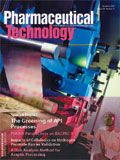
Drug Solutions Podcast: A Closer Look at mRNA in Oncology and Vaccines
April 30th 2024In this episode fo the Drug Solutions Podcast, etherna’s vice-president of Technology and Innovation, Stefaan De Koker, discusses the merits and challenges of using mRNA as the foundation for therapeutics in oncology as well as for vaccines.